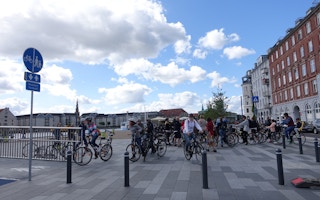The world’s cities today are facing multiple challenges, from exposure to climate change to concerns about social segregation to deepening health crises.
What’s more, these issues are profoundly interrelated. Urban planning policies that have prioritised cars over walking or bicycling simultaneously worsen air pollution, lengthen commutes and contribute to incidence of “urban diabetes”, which the World Health Organisation has called “a new urban epidemic”.
With public finances under stress worldwide, one thing’s for sure: Allocating municipal money to tackling these issues separately isn’t just ineffective—it’s unaffordable.
So how can cities address these challenges holisitcally? That was the question city leaders from five continents grappled with during a recent masterclass.
As Partner and Managing Director at Gehl—the global urban design consultancy— I hosted urban planners, engineers and architects from Barcelona, Bengaluru, Bogotá, Cape Town, Vancouver and several other cities to investigate how cities can become simultaneously healthier and more liveable while limiting carbon emissions.
The gathering in Copenhagen was part of a partnership between Gehl, the C40 Cities Climate Leadership Group and Novo Nordisk’s Cities Changing Diabetesprogramme.
Using Copenhagen as a laboratory, we walked and cycled the city and spoke with local officials about how Copenhagen became a world-class example of a healthy and liveable city. We learned how Copenhagen overcame barriers to walking and cycling projects, such as safety concerns, technical design, and maneuvering the local political context. We also discussed innovative practices in other global cities.
Each city came with a project back home to share and develop during the masterclass. Despite their very different local contexts, the city leaders faced similar challenges: a lack of technical expertise, trouble with data collection and difficulty in communicating the goals of pedestrian and bicycle projects to citizens and departments heads alike.
Five major themes emerged from our discussions and site visits—takeaways that all cities can learn from. Many of these themes are drawn from A Mayor’s Guide to Public Life, a book published by the non-profit Gehl Institute.
1. Measure what people do — right where they do it
Most cities have detailed data on cars, such as the number of cars on the road, travel time, areas prone to congestion, or the number of traffic accidents. However, cities have not traditionally collected what we call people-centred metrics—data on how people use and move through public space.
When you measure where people choose to spend time in public spaces, as well as what they do there, you get a better sense of which design or policy changes might best contribute to a city’s or neighbourhood’s public life.
Collecting people-centred data enables city leaders to make an evidence-based case for change, create buzz for projects and persuade sceptics to get on board. Such data can also reveal previously invisible or overlooked patterns.
That’s exactly what New York City did before making big changes to the layout of its famous Times Square. One key finding was that 90 percent of the space in Times Square was dedicated to cars, even though 90 per cent of the movement through the area actually took place on foot.
Based on this new data, then-Mayor Michael Bloomberg created new public spaces along Broadway and re-routed car traffic. The new public spaces and pedestrianization of Times Square transformed the area’s public life, increasing the number of people who stayed in public spaces by 84 per cent and improving vehicular flows along main avenues.
2. Put people first
People can sense where they are wanted. Signals surround us telling us whether or not we are welcome, such as “do not linger” signs or a lack of public seating in beautiful urban places. To put people first, every person needs to feel that they are welcome to participate in the creation and design of their city and to participate in public life— what we do collectively or alone—when we are not at home, work, or in our car.
Citizen engagement is the key to putting people first. A great example comes from Pittsburgh, where Mayor Bill Peduto has begun inviting city residents to meet with him and his staff through a programme called “Mayor’s Night Out”.
These events are opportunities for the mayor and city staff to meet citizens in different neighbourhoods and invite them to voice ideas and concerns. Similarly, a “Mayor’s Night In” programme opens the doors to City Hall, inviting residents to visit offices of top city officials and share their thoughts.
The success of these events is evidence of the results of putting people first by nurturing a two-way communication and democratising the city-making process.
3. Do test projects
While understanding the value of public life is crucial, actually implementing design and policy changes that improve public spaces for everyone is easier said than done. That’s why action-oriented planning is so important. This is a process of learning from pilot projects or interventions by testing them out and seeing what works before making long-term investments.
An example of an action-oriented approach to city building comes from Denver. The city’s 16th Street Mall, though a street for pedestrians and buses only, offered few reasons for people to spend much time there or spend money with retailers on the street.
To show that the street was worthy of transformation and investment, the Downtown Denver Partnership created a temporary event called “Meet in the Street”, a street fair with locally produced art, food, and cultural activities.
After piloting the programme on two Sundays, data showed that overall pedestrian activity levels increased upwards of 62 per cent, and the number of people sitting outdoors increased by 194 per cent. The event was later expanded to run over five weekends throughout the summer.
4. Formalise this approach
While enhancing a single park or street is worthwhile, the broader goal for mayors should be institutionalising people-centred approaches in government and civil society. This means finding ways to turn temporary interventions into more formalised efforts that can spread the culture of putting people first across city departments.
Copenhagen does this through an annual process of collecting data that is used to guide major public investments. It started in the 1990s with a strategy called a “bicycle account”—the behaviour of bicyclists was observed and recorded in order to inform investments in cycling infrastructure. The strategy has become a formal, evidence-based component of the city’s mobility framework.
Now, city officials have expanded on this with something called a “public life account”. A team is tasked with collecting data on how people are using public spaces and tracking progress over time.
In 2015, the city found 20 percent more people spent time in public spaces compared to 2010. And 80 per cent of residents felt satisfied with the public realm. The yearly collection of data has allowed Copenhagen to institutionalise the evaluation of public life and align its policies and investments in public space accordingly.
5. Ask better questions
If we want better cities, we need to ask better questions. When it comes to bicycling, for example, too many cities are content to simply ask how many kilometres of bike lanes they have, or how much money has been invested in them. Instead, they should be asking, as New York City does, how much more cycling is occurring. What’s more, they should hold themselves accountable by publishing their findings for the public to see.
To get good answers, all actors in a city must have a stake in asking the questions. For city leaders, it isn’t just about inviting more people to the table, but also re-imagining what the “table” actually is and being sincere about the power dynamics formed at those meetings.
City leaders need to put themselves on the line by targeting outcomes that may be out of their direct control. Architects and engineers need to be more critical in engaging with the “whys” and “to what ends”.
Citizens need to be empowered to exercise their voice by conducting public consultations in a shared, people-centred language of what matters. And businesses need to recognise that the city is an important stage for their employees, their customers, and their stakeholders.
For too long, human beings have been overlooked or even excluded in urban strategy. Starting with the people who live in a city as the common denominator can bring solutions, simultaneously, to many of the challenges that cities face. Now is the time to add people back into the equation.
Jeff Risom is partner and managing director with Gehl, a global urban design consultancy. He works at the intersection of urban design, governance, business and culture to deliver projects that are economically viable and socially equitable while efficiently using energy, land and time.
This story was published with permission from Citiscope, a non-profit news outlet that covers innovations in cities. More at Citiscope.org


















